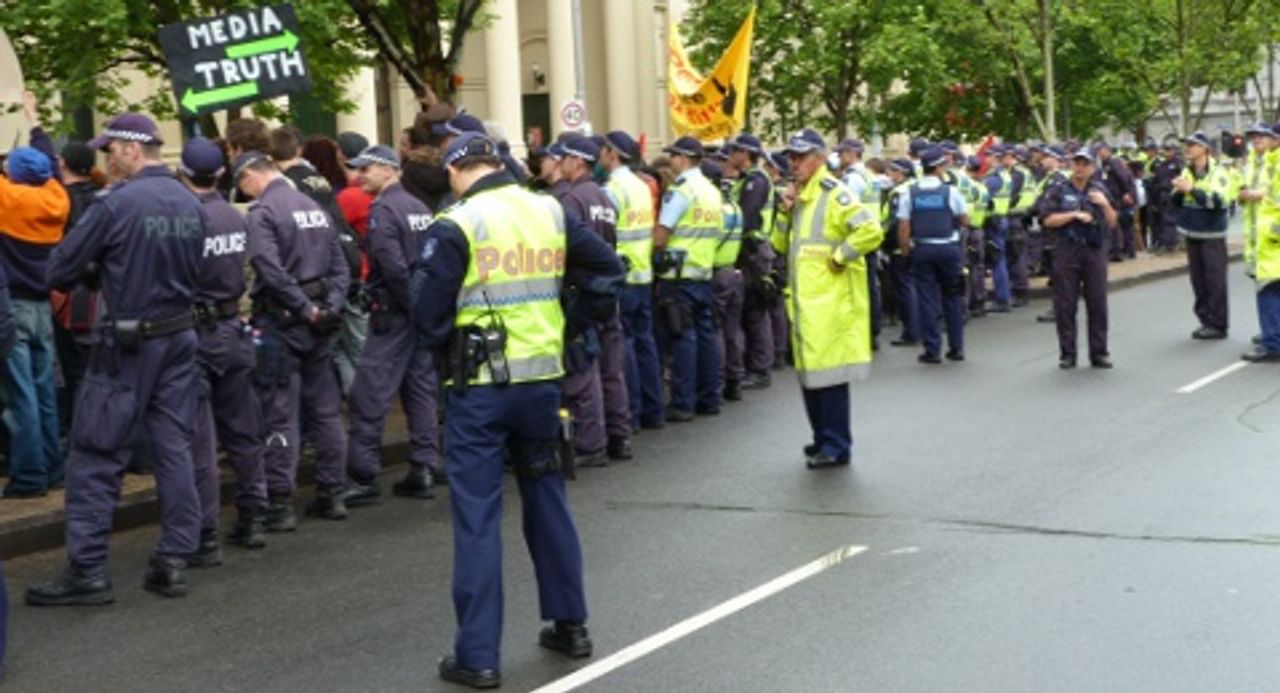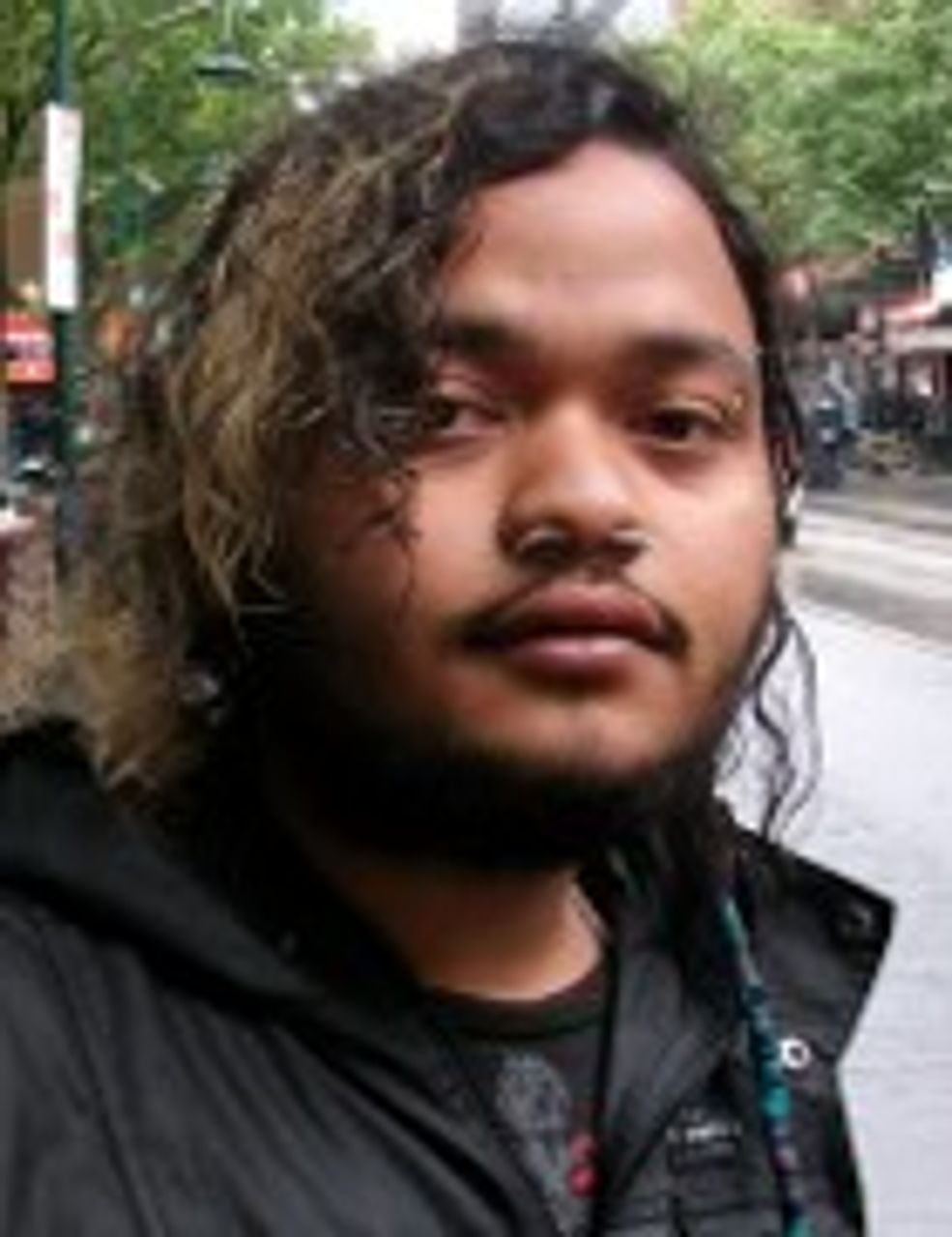A police operation was launched in Sydney in the early hours of Sunday morning to evict the Occupy protest that had been taking place in Martin Place, in the city centre, since October 15. The state attack followed the violent dismantling of the occupation in Melbourne’s City Square on Friday, and large police mobilisations in both cities on Saturday to intimidate the protests against social inequality and corporate power.
In Sydney on Saturday, close to 1,000 people rallied in Martin Place in support of the Occupy movement. The police presence was markedly increased, hinting at the preparations underway to attack the occupation, as had taken place the day before in Melbourne.
Up to 100 people were occupying Martin Place when several hundred police descended upon the site at approximately 4.45 a.m. on Sunday. The majority of protesters had just woken up when they were instructed they had 10 minutes to leave. Police, including from the Riot Squad and other specialised units, were deployed to physically drag out people who refused. As many as 40 were arrested and at least nine were charged and will have to appear before court. Protesters suffered a range of minor injuries as a result of police brutality.
Central Melbourne on Saturday, in the wake of the police attack on the occupation, had the feel of a city under lockdown. Police were deployed at the railway stations and intersections throughout the central business district.
Several hundred people, mostly students and young people, assembled at Federation Square before marching to the Trades Hall building―the headquarters of the state trade unions. As the marchers went past the former occupation site at City Square, which is now fenced off and closed to the public, the police dog squad displayed about 10 large caged dogs to intimidate protesters. The mounted police unit, which had charged into demonstrators the day before, was also present.
 Police surrounding the Occupy Melbourne assembly at Trades Hall on Saturday
Police surrounding the Occupy Melbourne assembly at Trades Hall on Saturday
Despite the police presence and rain, the demonstration grew as it proceeded through the city, reaching about 1,000 people. The protest concluded with participants deciding to resume the Occupy camp at a new location next Saturday.
On the weekend, Liberal state premier Ted Baillieu declared that the police “had to use a level of force”, and that “they have done it exceptionally well.” Melbourne mayor and former state Liberal Party leader Robert Doyle denounced the victims of police violence as a “self-indulgent rabble”.
The federal Labor government has registered its backing for the police actions. Treasurer Wayne Swan, while feigning sympathy for the “sense of frustration” over inequality, wrote in his weekly economic note that the protests in both Melbourne and Sydney had been “obscured by instances of violence”. In fact, the only violence was meted out by the state apparatus against demonstrators.
Swan proceeded to insist that “we [Australia] haven’t suffered the immense social dislocation and detachment that occurred elsewhere in recent years.” Such claims serve only to demonstrate the unbridgeable gulf between the majority of the population and the political representatives of the Australian financial and corporate elite.
The broad resonance of the slogans of the Occupy movement reflects the extent to which social inequality, financial stress and insecurity dominate the lives of workers and young people. Under conditions of global economic breakdown, the Labor government of Prime Minister Julia Gillard, assisted by the pro-capitalist trade union apparatus, is seeking to push through ever greater devastation on jobs, conditions and social welfare programs in order to protect corporate profitability. Labor is reviled by millions of people and its traditional support in the working class has collapsed.
The rapid resort to state violence against the Occupy protests is driven by the fear in ruling circles that they could provide an impetus to working class opposition and a starting point for the necessary discussion that must take place on a conscious political break with the Labor Party and the unions. The implicit anti-capitalist character of a movement against the global “one percent” poses the need for a new mass party of the working class―the majority―on the basis of a revolutionary socialist and internationalist program.
In both Melbourne and Sydney, the pseudo-left tendencies and handful of trade union officials that dominate the organisation of the occupations are doing everything possible to exclude any consideration of political perspective. At weekend assemblies, discussion was restricted to the details of planned rallies over the coming weeks. The sentiments behind the Occupy movement are being channelled into harmless protest appeals to the very Labor government and other forces defending the interests of the ruling class.
In Melbourne, a protest was called for October 29. A meeting of Occupy Sydney decided later on Sunday to hold a rally and march in the city centre on November 5.
World Socialist Web Site reporters interviewed people in Melbourne on Saturday about the police crackdown and the issues animating the Occupy protests.
 Daniel and Danika
Daniel and DanikaDaniel and Danika, a young couple from the outer working class suburb of Frankston, rallied to oppose the police attack.
“The government authorised the brutality,” Daniel said. “Because of the [police violence] the Occupy protest did get on the news,” he continued. “Before that there was nothing about it in the media. There was very limited coverage on SBS.”
Danika added: “In New York the protesters said it went from blackout to media circus after the arrests there.”
Daniel continued: “The one percent is the ruling class. The people in government are the rich people. You get to vote for one of two preferred parties that are very similar. If you want to be part of those parties, you have to buy your way in with lots of money. Look at Obama, his economic advisors are the same people who destroyed the economy in 2008. Many of them come from Goldman Sachs. And Obama has the highest ever war budget. Obama is preaching democracy in his own society, but the people don’t have a say at all....
“I became politicised because I couldn’t work due to a hip injury. I’ve had a lot of time at home to think. I’ve been able to observe the world we live in. Our system is not working. People can feel it. Everybody has a good idea there is something wrong. Where is Australia going to be in five years? We have to protest to try and change the system. Where do we go? We can’t take it to the government, that is not going to do anything.”
 Kad
KadKad described what he had witnessed on Friday: “I was in the camp contingent trying to protect the kitchen. We got run over by one of the horses ... They pulled us out and threw us into the street. They pummelled us so many times. They tried to run the horses into us. They broke my friend’s finger. They maced [capsicum sprayed] me. It was the most appalling thing I’ve ever seen. They broke noses. They broke one guy’s ankle. It was brutality to the max. They were pinning people to the ground and bashing them in the head. They went all out. In a country like Australia, it was unbelievable to see such brutality. I might have expected it somewhere else, but not here.”
